 |
 |
 |
 |
 |
 |
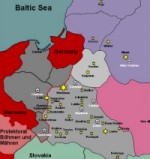 |
| Ghettos |
Jozefow near Bilgoraj was a typical Eastern Polish shtetl. Before the war its Jewish population numbered about 2,000, more then 60% of the total population of the village. The Jewish community was established at the beginning of the eighteenth century, when the town as a whole was founded. In the nineteenth century Jewish Jozefow was known for its very famous Jewish printing-house, which published Hebrew religious books. Before WW2 it was a poor, very provincial town, with orthodox Jews.
In September 1939 Jozefow was bombed by the German Luftwaffe, and a large part of the town centre was destroyed. At the end of September 1939 the Soviet Army entered Jozefow, but after a short occupation the Soviets left the town. Together with them, about 1,000 local Jews decided to escape to the Soviet Union. Only the poorest people stayed in the town.
At the beginning of the occupation life went on for the local Jewish population without special atrocities by the Nazis. The symbol of the new era was the Judenrat, whose president was Baruch Goldsztajn. Among its members was the local pre-war rabbi Szymon Parzenczewski.
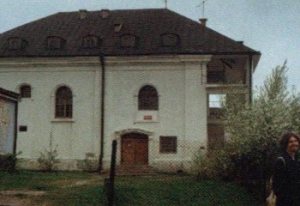 |
| Jozefow Synagogue |
Because of the extremely primitive living conditions, a typhus epidemic spread very quickly, especially among the Jews resettled from Konin. In 1941/1942 Jozefow was the centre of this epidemic in Bilgoraj County. It is important to point out that there was no hospital nor a Jewish doctor in the village, only an "isolation house" which was too small for all sick people. Among the Konin Jews were two dentists, but without medical equipment.
The conditions in Jozefow were described very well in a letter sent in 1941 by resettled Jews from Konin to the Jüdische Soziale Selbsthilfe in Krakow:
"We are in a small town, destroyed because of the war, among very poor people who in fact need our help. We are living in very bad conditions. ...We feel mainly the lack of food, clothing and shoes, because we have lost everything."
In the next letter to the same institution, M. Fürszt, the representative of Koninís Jews, who worked in the peopleís kitchen, wrote:
"There is no way for us to earn anything. The majority "are living" on what they can sell - clothes and linen. And even these things are almost finished. We are the leading place in the whole Lublin district for the number of people who have typhus. Death from starvation and hunger is visiting every home. It is horrible to see how our children, emaciated and pale-faced, are going from house to house pleading for bread."
In August 1941 living conditions became even worse when several houses in which Jews lived were burned down at night. About 200 people lost the little property they had and were made homeless. At that time, according to a Judenrat report, 2,147 Jews lived in Jozefow.
At the beginning of 1942, official rations for the Jews were 72 grams of bread a day and 200 grams of sugar a month. Sometimes they got 60 grams of soap and 1 litre of paraffin.
The first Aktion in Jozefow, connected with Aktion Reinhard, took place on 1 May 1942. The Bilgoraj Gestapo arrived in the village with the local head of that institution, Columbus. Gestapo men arrested 20 Jews in the village who were on a special list. They were accused of being Communists. In fact, throughout the county and in the neighbouring Zamosc County, the Gestapo and SS organised a wave of arrests of people who might potentially have been leaders of resistance when the deportations took place. The Jews, arrested in Jozefow, were taken to the Gestapo prison in Bilgoraj and nobody knew what happened to them. It is possible that, together with other Jewish men from Bilgoraj and Tarnogrod, they were deported to Majdanek concentration camp.
From then on, not a month passed there without "murder" visits by the Germans. As well as the Bilgoraj Gestapo, the local Jews were afraid of members of the Schupo and the Bahnschutz-Polizei (railway security police) from a nearby railway station in the village of Dlugi Kat. Their commander, Werner, was responsible for the death of many Jews from Jozefow.
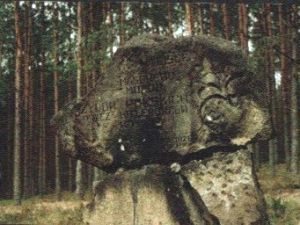 |
| 13th July Massacre Memorial Stone |
The largest single massacre, but not the final liquidation of the entire Jewish population, happened on 13 July 1942. On that day men of the 101st Reserve Police Battalion, commanded by Major Trapp, executed 1,300 - 1,500 Jews in Jozefow. These people were taken from their homes and gathered at the market square. There a selection was held - about 300 young men were taken to the railway station and deported by train to Lublin, probably to the Airfield Camp. The other people, after a short journey in trucks, were shot in the forest about 2 km from the village. The execution took place on both sides of the road to Bilgoraj, at a site which the local inhabitants called Winiarczykowa Gora (Winiarczykowa Hill). Many people were already killed in Jozefow itself - in their homes or on the streets. As some policemen stated after the war during their trial: "The bodies of the shot Jews were everywhere - on the streets, in the houses and at the marketplace."
After the first volley of shots was heard in the marketplace, the Jews gathered there started to scream, but in a few moments they became completely silent. The people went to their death in silence, and only in the forest, at the last moment, did some of them cry and some children scream.
By the evening the massacre was finished. The policemen went back to Bilgoraj, but not all the Jews had been killed. Some of them still hid in cellars or in the forest. Some, who were only wounded, came back from the execution site - no mass graves had been dug, but after the execution the local Polish population was given the task of burying the bodies.
We may suppose that about 200-300 Jews survived the execution, which very quickly became known in the surrounding towns and villages. As well as those who survived the massacre, new Jews very soon arrived in Jozefow. They were from nearby villages and had to move to Jozefow, where, according to an SS order, all Jews from the surrounding localities had to be collected. This group probably numbered nearly 300-400 people. Among them was Estera Fefer from Krakow, resettled from there in 1940 to Lukowa, a village near Jozefow. She survived, and after the war she wrote in her testimony:
"Jozefow was a town of death. The people were killed without an Aktion, for no reason. At Yom Kippur they (the Germans) took people according to a list of names. Officially there were 20 names on the list, but they took 70 people. They were taken to the fire station where they were beaten horribly, and then they were shot in the quarry behind the town, near the forest. During this Aktion the local Polish population was very helpful."
This group of people was shot because Columbus, chief of the Bilgoraj Gestapo, ordered a high contribution to be gathered from the Jews in Jozefow. Because the local Judenrat did not give him the money in time, these 70 Jews were killed as hostages. This happened in September 1942.
On 3 November 1942 the final Aktion was organised in Jozefow, and afterwards the village was claimed to be judenfrei ("free of Jews").
Until the end there was no ghetto in Jozefow. The Jews lived mainly near the market and on the main street. The man, responsible for this last Aktion, was Werner, commander of the Schupo from Dlugi Kat. As well as this unit, railway police and Polish police also participated in the liquidation of Jozefow's Jews. All Jews who did not escape to the forest were gathered in the fire station, and then had to walk to the railway station in Dlugi Kat. On the way, many of them were shot - their mass grave is located at Chojniasta Gora (Chojniasta Hill). Others were deported from Dlugi Kat to the Belzec death camp. The group probably numbered about 200 - 300 people. These were the last deportations to Belzec from Bilgoraj County.
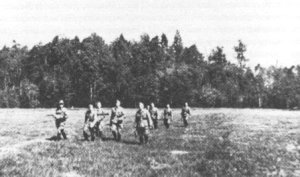 |
| Policemen Hunting for Jews |
In 1943 Polish and Soviet partisan units operated in the region, and some Jews joined them. In the Jozefow region partisan battles took place, especially after June - July 1943, when the Germans organised a large-scale pacification action against the Poles. Some more major struggles took place in June 1944, under participation of armed Jews. Finally, in July 1944, the Soviet Army entered the region and a small group of survivors was liberated, including Estera Fefer with her family.
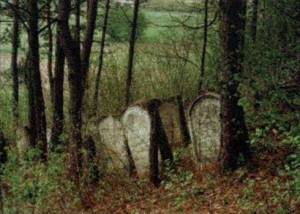 |
| Jewish cemetery |
Sources:
Lublin State Archives: Collection of documents, gathered by Dr. Zygmunt Klukowski of Szczebrzeszyn, 1944-1946.
Archives of the Jewish Historical Institute in Warsaw: Documents of Jüdische Soziale Selbsthilfe; Testimony by Holocaust Survivors - Testimony by Estera Fefer.
Archive of the Majdanek State Museum: 1942 "Death Book".
Z. Klukowski: Dziennik z lat okupacji (Diary of the Occupation Years), Lublin 1959.
Ch. R. Browning: Ordinary Men. The 101st Reserve Police Battalion and Final Solution in Poland. Harpers Collins 1992.
© ARC 2005